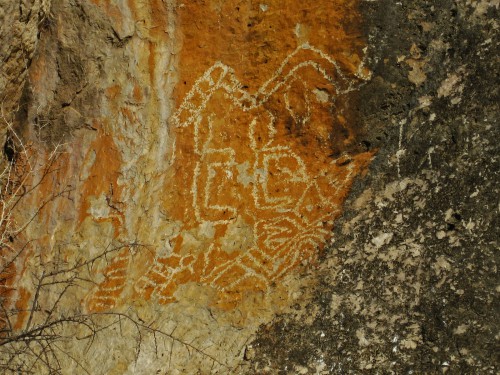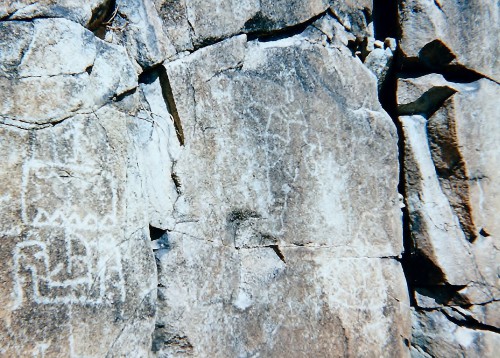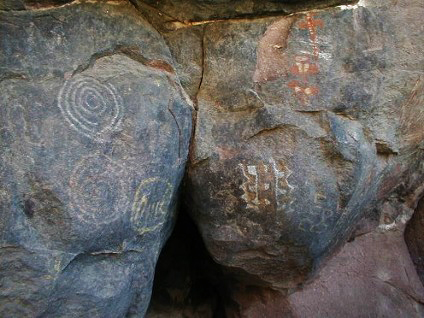
By David Kier
Rock art sites are some of Baja California’s most interesting attractions. They are found throughout the peninsula and the art takes on many forms and styles from place to place. The native people recorded their culture by depicting animals, food, battles, weather and more. Probably more is unknown than known as to what was the full message.
Two varieties of rock art found are petroglyphs and pictographs. A petroglyph is art that is ‘pecked’ or rubbed into a rock face by contacting the surface with a harder stone and exposing the lighter colored rock beneath. A pictograph is actual painted art on a rock face where the paint was created using different mineral sands mixed with water, vegetable matter, or blood. Red, yellow and black being the most common colors.
Because the number of visitors to these ancient sites has grown over the past century, great care must be exercised to preserve these windows into man’s past. The rock art sites in Baja California have been estimated to range in age from 700 to over 7,000 years. Never touch the rock surface of an ancient site because skin oil and rubbing will damage the art. Leave the art work where it has been for centuries so future visitors may also enjoy them.
The state of Baja California Sur is perhaps best known for the giant cave art made famous by author and Baja explorer Erle Stanley Gardner in the 1960’s and later by researcher and history author Harry Crosby. The art is world famous and tours to them create an important resource for the local economy. Less known to the outside world are the rock art sites of the northern half of Baja California. Here are some examples:
 Las Pintas
Las Pintas
Las Pintas is a large boulder area with petroglyphs dating back 2,000 years and perhaps to 3,000 ago. The art has been added at the site up to mission times, based on the subject matter displayed. It is believed that Las Pintas is the southernmost example of Great Basin Abstract rock art. It contains very little hunting imagery (common at many other sites). Instead there is more religious ritual style art. This tends to indicate Las Pintas was a ceremonial location and not a native village site.
To reach Las Pintas, a four wheel drive is recommended for the final miles. Go 14 miles southbound on Highway 1 from El Rosario to the graded dirt road to Punta San Carlos (near Km. 80). Go just over 17 miles south on the San Carlos road and take a dirt track to the left. Then travel along and eventually down into the Arroyo San Fernando riverbed for 5 miles. Take a faint track to the left, leaving the big arroyo for 2/10 of a mile to a fork and go right. In less than two miles the road ends at the base of the boulders that are Las Pintas. Passageways are between and under the boulders. A trail climbs to the right up to the top, and more rock art is along the top to the right. A road also circles around to the top, on the west side. A full day is not enough time to see all that is at Las Pintas!
 San Fernando de Velicatá
San Fernando de Velicatá
San Fernando de Velicatá is the 1769 mission founded by Junípero Serra on his overland journey from Loreto to San Diego. On a cliff face just ¾ mile west of the mission are some curious petroglyphs believed to date back up to 1,000 years. The site was more extensive and easier to view in the past. The river erosion and intentional destruction by missionaries during their building of an irrigation canal have reduced the site. Odd figures, and what appears to be Roman numerals, and a Spanish galleon shape, have made this site interesting to ponder by many over the years.
 Montevideo
Montevideo
Montevideo is one of the extensive pictograph (painted) rock art sites that is easily reached in a four wheel drive vehicle. The tall cliff face was a giant easel for ancient artists who began painting here as much as 10,000 years ago. Many colorful patterns, including lightning bolts, await those who make the trip in through one of Baja California’s finest examples of desert vegetation. Take the signed road to Mission San Borja from the Bahía de los Angeles highway (27 miles from Highway 1 or 13 miles from Bahía de los Angeles). Go south two miles to a side road left and go 5.8 miles to the side of the cliff. The rock art is all along the cliff face.
David Kier is a history and Baja expert and co-author of “The Old Missions of Baja & Alta California: 1697 – 1834.” He’ll be leading our Baja California Missions Trip October 20-19, 2015 to see all three of these rock art sites as well as Missions and other archaeological and historical sites. Don’t miss this once-in-a-lifetime trip!
